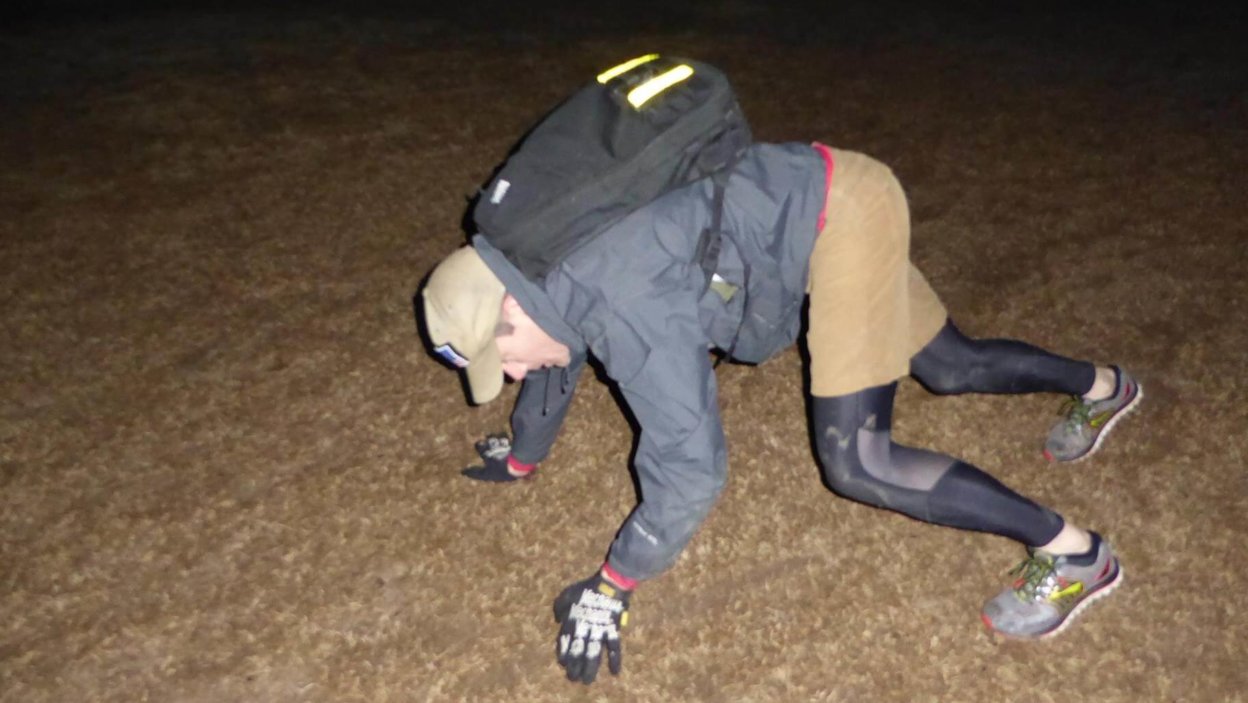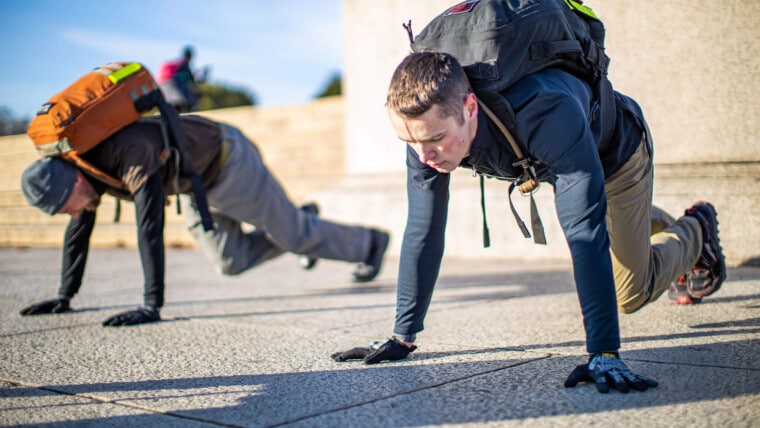Failing to plan is planning to fail.
In just over three months I’m going to attempt the first GORUCK HTL and I have given a tremendous amount of thought to my training plan and how I should prepare. I want to outline a training plan below and, while I can’t recommend that you follow it at this time, I want it to be here so that I can better evaluate it at the end of my events, tweak it, and offer it as a potential resource to anyone looking to accomplish and HTL. (Update: While my training was good, I was not able to finish my HTL. Here is my AAR on why I failed.)
When it comes to my training there are several specific areas that I need to invest my time and energy over the next three months. In particular, they are strength, endurance, mental toughness, work capacity, gear, and diet.
Strength
I recently read Built to Endure – Training the Tactical Athlete by Mike Prevost and while the science side of the book was a little difficult for me to understand, I do appreciate what I gained from the author in relation to training for strength. It was helpful to be reminded that when I’m training in the gym, training for the strength is different than training for a beach body. Prevost recommends focusing on traditional lifts like deadlifts, squats, strict press, and bench press. All of these lifts will help contribute to the development of my absolute strength. And, while there were a lot of pages devoted to the science of how and when, Prevost ultimately says, “Best strength training looks a lot like a simple powerlifting program. That is because a simple powerlifting program is the most effective way to build strength in the 5 basic movements.” (He defines the 5 basic movements as Upper Body Push, Upper Body Pull, Squat, Hip Hinge, Core.)
It was helpful to be reminded here that I’m not looking to come up with some ridiculous number for my 1 rep max on the lifts. While being able to do a 600 pound deadlift is certainly cool, the amount of training and effort to get to that result is perhaps not the best overall training philosophy when you want to be a well-rounded, strong athlete.
For me, this simply means that I need to be in the gym at least three times a week working on my strength training. I currently work at a CrossFit gym in Richmond, so this works out very well for me as the training program I’m a part of always contains a strength training element to it, so I’m consistently working to develop my overall strength numbers.
PT
I debated for a while whether or not I would include this next section under strength or not, and I’ll probably address it again later, but for me I know that I have several areas that I need to improve when it comes to PT. In particular, I know that my push-ups burn out pretty quickly. Currently, my two-minute max rep test is around 50. And while I feel like that’s a pretty good number, the problem comes when multiple sets required i.e. a PT-Beat-Down session. For this reason, over next three months I have chosen to invest some of my training time to working on my push-up volume I’m doing this by using the grease-the-groove technique. Essentially doing push-ups and smaller sets all day long. Along with greasing the groove, also incorporate push-ups and my regular Metcon workouts at the gym.
Other week points in my PT are flutter kicks. So, much like with push-ups, I’m adding those into workouts as often as possible.
Endurance
An HTL lasts about 48 hours. Even with breaks in between events, that’s a long ass time to be putting out work. So I want to make sure that my body has the ability to endure during all those long miles under weight. This is where I’m focusing on my ruck training. Simply put, I’ve got to put miles under my feet with weight on my back.
While Prevost covers a training program for rucking and his book, I didn’t feel like it was going to adequately prepare me for what I would face in HTL. I’ve decided to use the Team Spearhead Pathfinders training program as the base for my ruck training. From what I’ve heard, it’s a really great program and is help people successfully complete numerous GORUCK events.
My plan is to work hard to stick closely to the ruck training program, adding more distance and weight as necessary.
Along with just the general ability to endure 60+/- miles over the weekend, I know at the beginning of the Heavy involves a 12 mile timed ruck. In all of my ruck training I intend tp wear a GPS watch. This will allow me to monitor my average pace as I work. I want to pay special attention to this to get a really good feel for what my pace is. Knowing what a 12, 13, 14, and15-minutee pace feels like will come in handy during the 12 mile rock so that I know where I am within the time hack and I won’t feel the pressure to expand more energy than is necessary.
Work Capacity
Work capacity ultimately deals with how much work I have the capacity to actually put out. In my mind this is actually an overlap between strength and endurance. Across the 60 Miles in 48 hours I’ve got to work and I’ve got to use both strength and endurance the entire time. My weekly training program should help as I focus on both strength and endurance to increase my overall work capacity.
To improve my work capacity my workout plan includes various metcon workouts at the gym ranging from 15 to 45 minutes in length during which time a consistent amount of work has to be put out. It is also my understanding that the Team Spearhead training program does a great job of incorporating workouts into your rucks, for example rucking to the gym before and after a workout. Doing this gives me the experience putting in miles and getting a beat down and then putting in more miles
Mental Toughness
Mental toughness is a topic that I thought a lot about (I also wrote something about it). I usually think about mental toughness the most in the middle of particularly grueling workouts. A voice inside my head often screams at me saying, “what the hell are you doing?”
I thought long and hard and read several books on how to tell the voice in my head to shut the hell up. I figure in the midst of an HTL I’ll have more than enough opportunities to face that voice in my head, so as much as I want to train my body, I need to train my mind.
In some regards, the sheer volume of training I will be doing over the next three months will be helping prepare my mind and getting me mentally tough. The commitment to get out of bed each morning to put in the work takes a mental commitment and will help prepare me for the challenges during the events. But showing up is not the entirety of the battle. Staying in the battle and continuing to work is where the rubber really hits the road.
So, when it comes to training, the first step is to commit to putting in the work from my training program, even when I don’t feel like it. It also includes things like not taking any form of music on my long rucks and workouts, enabling me to engage fully in my mind and the battle rages between my ears
The second part of my mental toughness training is to do some reading. I want to read some books the people that faced incredible difficulties and overcame the challenges. Currently I’m reading Swimming to Antarctica about a long distance swimmer. It’s fascinating to listen to her talk about the mental aspect of the challenges she faces during 5 to 10 hours into a swim (and the insane amount training it took to get her where she is today). Understanding how other individuals face and overcame the mental element of a physical challenge is a great source of encouragement and insight.
Gear
It’s really important to me over the next three months to fully locked down the gear I want to use it. Currently I rock the GR1 and I’m happy with that as my ruck of choice. I also feel very comfortable and confident with the shirts and shorts that I wear while rocking it.
When it comes to my ruck itself, the one thing I’m considering is trying out the sternum strap and potential he waist belt. I’ve never used either of these but I wonder if they might help during such a long event.
The biggest problem for me, comes with my feet. Currently I rock and Brooks Glycerin 12’s. These are road running shoe and I really like them. However they really fail when it comes to their durability. Of course there is always the great debate when it comes to rucking in boots versus shoes. It seems that the conclusion is use what feels best to you. So, I always seem to be on a quest to find the answer of what works best for me. I like my Brooks, but I’ve also tried a pair of Solomon. I hated them. They felt like a pair of giant sponges on my feet whenever they got wet seem like they would never ever could drive.
I’ve wanted to try a pair of boots, however being someone that’s never worn them they feel horribly uncomfortable on my ankles and I simply can’t get over it. I understand that boots are great for longer events because they help give your ankles the support they need to endure such long activity underweight, however if it doesn’t feel right that puts me in a worse position
So, at this point I’m pretty committed to sticking with my current shoes, though I’m open to trying to find new ones and pretty much try new ones on any time I’m near a shoe store.
After shoes comes socks
The thing about socks when they get wet they hold water. Thick socks hold more water. The problem is that thin socks tend to result in more foot discomfort for me. So, towards the beginning of my training plan to try several different sock options, both think and thin. I even saw you crazy people suggest wearing two pair of socks, so I’ll give that a try. Of course it’s super important when testing shoes and socks to always test them and both dry and wet conditions. So, every time I try a new sock or shoe combination I always require myself to put at least 2 miles and after having thoroughly soaked them in a creek on the trail.
I really hope to have the right shoe and sock combination by the end of my first month of training.
Diet
Increased work and training means I need to make sure my body is getting enough fuel. I’ve set up some caloric goals and basic macros to hit every day. This will assist me in my recovery and helping my body be at its best when I go to train.
Honestly, this is the area I know and care the least about. Thankfully, my wife loves this stuff. So, she has set my daily numbers and all I have to do is make sure I hit them. We use myfitnesspall to track them.
So, what the heck is all this look like?
I think it’ll look something like this (including pushups every day).
Monday – NSW Class at Gym
Tuesday – Rucking
Wednesday – Open Gym
Thursday – Rucking
Friday – NSW Class at Gym
Saturday – Longer Rucks
Sunday – Rest
So, that’s the gist of what I plan on doing and how I’m approaching my training. I think I will likely post my weekly workout and rucks as a reference starting in June.
If you have any questions, or think I should add anything, drop it in the comments below.
EDIT – Oh yeah, forgot to mention, I’m doing my HTL on 9/11. That gives a high likelihood for doing stairs… lots of stairs. So, I’m adding lots of those in wherever I can.









2 Replies to Training For My First GORUCK HTL
Hey so I’m new to Goruck and your articles. Read a few within the first day and I find them very interesting and informative. I have a background as a Marine and I CrossFit. I’m 43 and want to do some events. So I guess my question to you is, what size (pound) sand bag do I need? I wanna train for the rough and heavy but don’t wanna buy all the different weights in the sand bag. How many pounds are they using in the events? I also weigh 210 if that makes a difference.
SF amigo 3/6 0351 and STA plt. I know it a bit after this post but I hope you reached your goals. If your still on your quest for your bolts let me know as I’ve done a few and hit an HH. Ryan is the man and really enjoyed doing the Veterans Day HTL which really would’ve been his third as he killed it.
Comments are closed.
Review of the GORUCK Footwear Lineup
Which GORUCK Bag Should I Buy?
GORUCK Ruck Plate Carrier vs. Training Weight Vest for Rucking
GORUCK Weight Vest Review (with Video)
Which GORUCK Bag Should I Buy?
GORUCK Rucker 4.0 Review
GORUCK Simple Sandbag & Sandbag 2.0 Review
GORUCK Weight Vest Review (with Video)